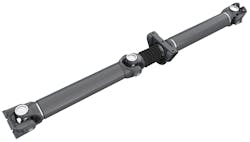In the trucking industry today, noise, vibration and harshness (NVH) levels are at the forefront of vehicle design strategy for many reasons. Driver comfort is extremely important, and drivers have come to expect heavy duty line haul trucks to operate similar to a passenger car. Unexpected vibrations can lead to driver fatigue and dissatisfaction, as well as expensive downtime in diagnostic and repair efforts.
In the midst of this quest for a smoother, quieter ride, other trucking industry trends such as engine downspeeding have had an effect on vehicle dynamics and harmonics, often contributing to NVH issues. Component manufacturers and OEMs have adapted truck designs accordingly.
A collaborative solution
This multifaceted industry concern requires a highly-engineered, collaborative solution. The Technology and Maintenance Council (TMC) of the American Trucking Associations has made the investigation of ride complaints and NVH issues a top priority, led by Jim Holman, engineering manager at Dana Incorporated. Holman and a team of fellow industry experts are in the process of updating TMC’s recommended practice on troubleshooting vehicle ride complaints – otherwise known as Recommended Practice (RP) 648.
While the driveshaft or tires are often assumed to be the NVH culprit, the group believes that the problem of vibration in the powertrain should be handled with a systematic approach.
NVH issues may be rooted in a variety of vehicle configurations and can interact with the natural frequency of many parts of the vehicle such as the transmission, axle, suspension, clutch, tires, dashboard, door panels or other components. A technician should investigate beyond where the immediate symptom is being experienced, and the updated RP 648 will systematically lead the technician through a step-by-step process.
TMC’s main purpose is to publish recommended practices on a wide variety of trucking industry topics. For more than 30 years, their Recommended Practices Manual has been recognized as one of the leading maintenance guides for commercial vehicles, containing the best equipment maintenance and maintenance shop management information available.
RP 648 offers a comprehensive guideline to diagnosing ride complaints in heavy duty tractors and trucks. In its current form, it exists as a 58-page document that proves challenging for the average technician to use as a diagnostic tool. The update will make it more user-friendly, written so that a qualified truck technician with limited prior ride and vibration diagnostic experience will be able to follow a simple procedure to identify the root cause component in a timely manner. The group plans to take RP 648 and compartmentalize it into three easy to follow sections including:
- Troubleshooting to identify and document the complaint
- Diagnostic procedure in the form of a flow chart to identify the root cause component
- Reference/glossary to identify terms
This update is supported by leading OE manufacturers and suppliers across the trucking industry. The group plans to provide an update at the next TMC Annual Meeting & Transportation Technology Exhibition, scheduled for March of 2018.
NVH driveshaft options
Leading the industry-wide effort to improve NVH performance, Dana has also developed its own technology to address growing market needs and is continually working to improve these innovative technologies. The Spicer AdvanTEK 40 tandem axle incorporates quiet gear technology. Spicer driveshafts are designed with NVH performance in mind.
Earlier this year, Dana introduced the SPL 350 Lite driveshaft as the next generation of lightweight, durable driveshafts optimized for downspeeding on high-torque commercial trucks. This series of driveshafts has been precision engineered to meet the industry’s NVH needs in a high-performance design. To address vehicle sensitivity, this design has resulted in one of the most precisely balanced driveshafts in the industry.
The SPL 350 Lite driveshaft is up to 35 lbs lighter than existing products, making it the lightest weight driveshaft in its class. Offering improved performance, enhanced vehicle dynamics and easier maintenance, the SPL 350 Lite driveshaft also delivers the durability and reliability required to support torque-management needs resulting from fast axle ratios to enable engine downspeeding. This positions Dana for powertrains of the future that enable further engine downspeeding, supporting axle ratios lower than 2.26.
The solutions in the SPL Lite Series of driveshafts have been designed specifically with fleets in mind – with fewer components, reduced weight, and improved NVH performance. These driveshafts share service components with their existing SPL Series counterparts, increasing ease of service and simplifying inventory for truck owners and service facilities.
Tom Bosler is the director of global driveshaft product planning for the commercial-vehicle business at Dana Incorporated. With a career at Dana spanning more than 30 years, Tom is proficient in Six Sigma operations management, as well as program and product development. Based in Maumee, Ohio, Dana is a world leader in highly engineered solutions for improving the efficiency, performance and sustainability of powered vehicles and machinery. Dana supports the passenger vehicle, commercial truck and off-highway markets, as well as industrial and stationary equipment applications.
